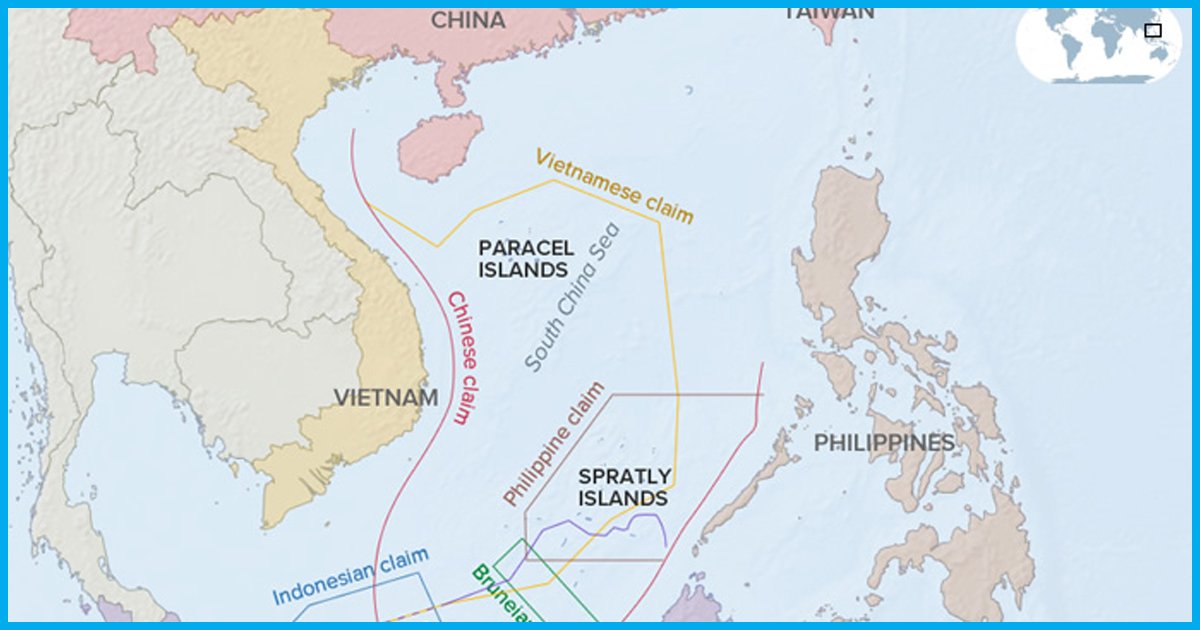
Why Is China Building Islands In The South China Sea?
22 Sep 2017 12:27 PM GMT
Editor : Sudhanva Shetty Shetty
Writer, coffee-addict, likes folk music & long walks in the rain. Firmly believes that there's nothing more important in a democracy than a well-informed electorate.
A strange thing is occurring in the South China Sea (SCS). Artificial islands are being built in the region by China to up-end different countries’ claims and maritime sovereignties.
One of the most strategically located geographical entities, the Sea has become a flashpoint for international conflict and the most geopolitically significant maritime body in the world today.
Six countries – China, Brunei, Vietnam, Malaysia, Philippines and Taiwan – are party to the dispute.
This maritime conflict is centred around islands in the South China Sea, many of which have been artificially constructed by China.
Each country in the conflict has differing claims regarding the extent of water they have sovereign control over.
Most countries base their arguments on the United Nations Law of the Seas, which states that a country’s territory extends 200 miles off its shores – which is an area called the exclusive economic zone (EEZ). All commerce that occurs within a country’s EEZ belongs to that respective country while the region beyond the EEZ is governed by UN maritime law (meaning, it is shared by everyone).
Out of the six countries involved in the conflict, five of them more or less abide by the UN’s EEZ laws – except for China, which claims historical conquests as justification for ownership over large swathes of the Sea, well beyond its own EEZ.
Disputes are mainly regarding the sovereignty of the Spratly Islands, Paracel Islands, Scarborough Reef, Pratas Islands, Macclesfield Bank and maritime sea surrounding the islands.
China’s island-making experiment
China has slowly but steadily intensified its military activities in the SCS. Over the past couple of years, Chinese dredgers have transformed highly sensitive corals reefs in the disputed Spratly archipelago into artificial Islands – alleged to be used for military purposes. They have reclaimed land enough to operate military aircraft in the region.
Ecologically speaking, various experts have said that if dredging and sedimentation continue it would destroy highly sensitive coral reefs and biodiversity associated with it. Even the UN Permanent Court of Arbitration in its judgement criticized China for “permanent and irreparable harm to the coral ecosystem”.
In October 2015, the US sailed a guided-missile destroyer within 12-nautical miles of the artificial Islands – first in a series of action planned to assert freedom of navigation in the region. China warned the US that it “should not act blindly or make any trouble out of nothing”.
Russia and China have also begun their Joint military exercise in the SCS adding a new twist to ongoing tensions over China’s island building in the region. Part of the exercise also contains practising “island seizing”. This exercise with Russia against the backdrop of recent ruling by UN Permanent Court of Arbitration is seen by many as Russia’s support to China regarding SCS dispute.
Recently in July 2016 an arbitral tribunal constituted under United Nations Convention on the Laws of Sea (UNCLOS) ruled in favour of the Philippines at the Permanent Court of Arbitration at The Hague. China immediately criticised the ruling claiming that the court has no jurisdiction over the dispute. China prefers resolving the dispute through bilateral negotiations. When settled bilaterally due to its sheer size and power compared to other disputants it would have a diplomatic advantage.
Why the SCS is significant
Apart from navigational rights and the strategic location, resources are the key drivers in the SCS conflict. The US Geological Survey estimated in 2012 that 12 billion barrels of oil and 160 trillion cubic feet of natural gas might exist as an undiscovered resource in the SCS, excluding the Gulf of Thailand and adjacent areas. The Ministry of Geological Resources and Mining of the People’s Republic of China estimate that the SCS may contain 17.7 billion tons of crude oil.
Additionally, the SCS is the largest source of fish, an important foodstock in each of the claimant countries. The fishing industries of each of the disputants include a large number of vessels which travel increasingly farther from their home coasts due to overfishing in coastal waters.
India and the SCS dispute
India in June 2016 along with Japan and United States has taken part in Malabar exercises involving aircraft carriers, guided missile cruisers, guided missile destroyers among others.
India has strong interest in keeping sea lanes open in the South China Sea. Almost 55% of India’s trade with Asia-Pacific passes through SCS. Apart from helping securing energy supplies for countries like Japan and South Korea India has unique distinction of shipping oil from Sakhalin to Mangalore through sea routes of this region. Therefore, it is extremely important for India to have access to this region.
India’s ONGC Videsh limited is involved in offshore exploration in SCS belonging to Vietnam (not recognised by China). China on numerous occasions warned India against such exploration. India until today has shown no indication to withdraw and continued to emphasize that its offshore oil explorations are within the territorial waters of Vietnam.
With India’s Look East Policy and Act East Policy gaining importance with respect to foreign policy are concerned stability and security over SCS is of extreme importance. India is seen by many Southeast Asian countries as a counterbalance to Chinese aggression.
Should China follow India? The same court that gave its ruling on SCS also ruled against India. The court ruled in favour of Bangladesh in a three-decade long maritime dispute. India despite the ruling being not favourable accepted it. The United States cited this example and urged China to follow India to resolve maritime disputes.
With India being Asia’s pivot to the United States complementing with India’s Act East Policy, New Delhi involvement in SCS and corresponding conflict with Beijing could see a steady rise.
 All section
All section













